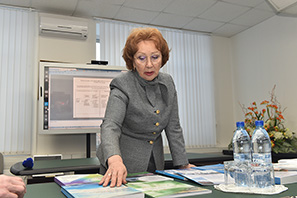Federal Scientific Center will study the health risks and make assessment of the effectiveness of targeted measures, developed by Perm krai government aimed to reduce cardiovascular and cancer mortality
Prospects for cooperation between the Federal Scientific Center for Medical and Preventive Health Risk Management Technologies were discussed at the meeting of the Governor of Perm Krai and the Scientific Director and the Director of the research Center.
In the year 2019 an extensive work in the interests of the inhabitants of Perm Krai under the regional program for the realization of national projects intended for cardiovascular and cancer morbidity reduction aimed to estimate the effectiveness of the targeted program, developed by the Government of the Perm region, will be carried out. It will facilitate the immediate regulation of the list and structure of measurements, what should help to achieve the required indicators. The Director of the Center, Dr, Vadim B. Alekseev explains, “The administration of Perm Krai is lining up a three-level system of health-care delivery in case of cardiology and oncology diseases. Will be closed an existing gap between the primary level (primary physicians) and regional institutions. Thus the interregional medical centers will be created. This process involves carrying out an organizational work, as well as providing the new centers with stuff, drugs and equipment. Our task in this process will be to set priorities on each territory of Perm Krai, basing on their specificity.”
Scientific Director of the Center, fellow of the Russian Academy of Sciences N.V. Zaitseva, presented to the Governor a project of the new building in the Kamskaya Dolina, which will consolidate the scientific and medical potential of the institution. The laboratory complex has been already constructed. The total area of the complex under construction will be more than 20 thousand square meters, the volume of the federal investments - more than 1.5 billion rubles. The complex is expected to be a place for unique computing and laboratory equipment, clinical facilities. It is assumed that in 2020 all the buildings will be finished and all engineering communications will be provided, from 2021 the interior decoration and installation will begin. By 2023, the facility is scheduled to be put into operation.
The research center, starting in 2010, having received the federal status, performs more than 30 comprehensive research projects annually. Research is conducted at the international, federal and regional levels. The surveyed territories included regions of the Russian Federation from the Republic of Crimea to the city of Bratsk.
An important activity is the harmonization of the international regulatory framework in the field of sanitary and epidemiological well-being, for example, for the tasks of the Customs Union. A direction for a scientific substantiation of risk assessment in the field of consumer rights protection, taking into account the principles of international organizations of the OECD, WTO, etc. is being developed. Works are being carried out to provide scientific and methodological support for planning, implementing and evaluating the effectiveness of control and supervisory activities of Rospotrebnadzor using risk-oriented model and based on long-term, in-depth research of the scientific center. In the direction of the development of the scientific base of hygienic assessments, investigations and examinations we continue performing high-tech fundamental studies of the violations of the proteomic profile of human blood plasma under conditions of combined exposure to chemical pollutants as elements of the evidence base of the harmful effects of risk factors. Moreover the profiles of biological effect markers for a number of specific types of effects were substantiated, which provides Rospotrebnadzor with reliable arguments in justifying the requirements for economic entities as well as new data on the safety (danger) of nano-materials were obtained. So, for example, in the experiment, it was proved that nanosized aluminium oxide has genotoxicity, cytotoxicity that causes protein expression, the ability to induce negative changes in cells and accumulate in the brain, lungs, kidneys, liver), has a high degree of potential danger. New gene markers are obtained for the quality control of genetically modified (transgenic) organisms based on genetic analysis methods (real-time PCR).
The particular importance belongs to the implementation by the scientific team of examinations of the sanitary-epidemiological state with the assessment of the risk to human health in emergency situations. Research results have a huge practical significance in providing the population, individuals involved in management decisions, the media and public organizations with reliable and scientifically based information on exposure levels, chronic exposure and health risk, requiring the necessary sanitary and anti-epidemic measures, as well as recommendations on individual prevention for different groups of the population in the presence of threats to health related to the environment.







